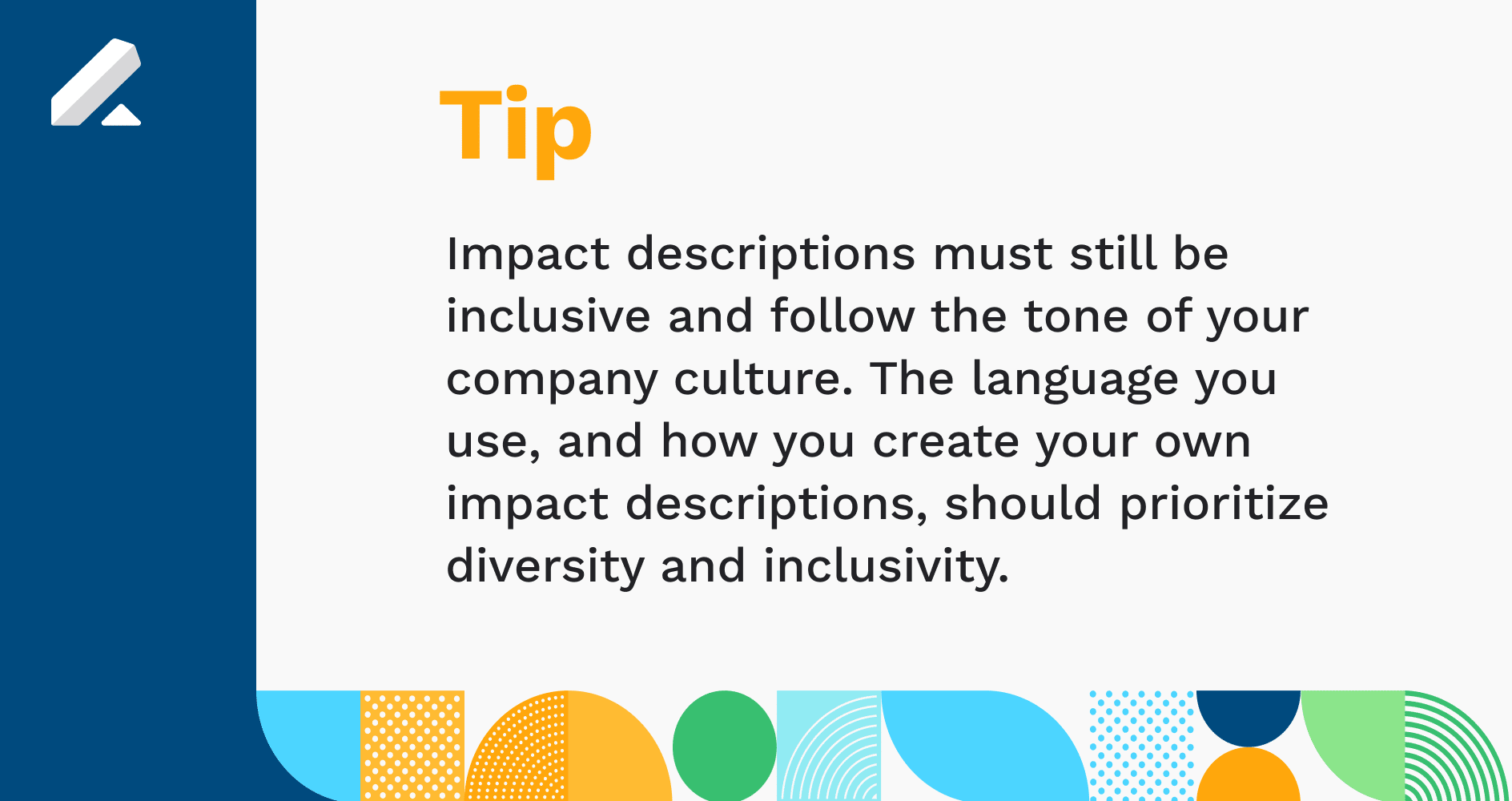Job descriptions are one of the least-evolved tools in a recruiter’s arsenal, not for lack of trying to modernize them, but because they are company-focused, not candidate-centric.
At Lever, we believe there’s a better, more effective way to leverage job descriptions for recruiting top talent: impact descriptions.
Impact job descriptions focus more on outcomes, impacts, and performance rather than a rigid set of tasks or responsibilities for a role.
In other words, impact descriptions emphasize the impact an employee can have and the contributions they can make instead of focusing solely on what they’ll do in their day-to-day.
When creating impact descriptions, you take an outcome or performance-based approach which identifies two important dimensions of a role:
- What is the candidate expected to own, teach, learn and improve once they’re in the role?
- What should a candidate accomplish, and when? How will the candidate’s career progress throughout the year?

How do you create impact descriptions?
While every organization will create job descriptions differently, when it comes to impact descriptions, there’s a simple three-step process you can follow:
- Begin by creating your own description framework (how will you develop more effective and inclusive job descriptions, and how will you make that process repeatable?)
- Align motivators with the goals or objectives of the role (why would a candidate want to apply to the role, and how does it match with their own goals?)
- Focus on specificity over ambiguity (the clearer your descriptions are, the more effective they’ll be in attracting the right candidates based on the role)
We walk you through everything you need to know to craft the best job descriptions here, but let’s break down the three steps above, further.
Start with an impact description framework
Recruiters practice both inbound and outbound recruiting — and job descriptions are part of these hiring strategies.
It’s inevitable that candidates will need a job description, regardless of whether they came to our company through a job posting or your hiring team engaged them through outbound initiatives.
But, how do you create job descriptions that serve both types of recruiting? The answer is impact descriptions, which can help you better source, engage, and nurture talent you want to attract and hire.
Sourcing and nurturing are vital components of talent relationship management, so a framework for how you develop impact descriptions can help with inbound and outbound recruiting.
“Back in 2014, we came together as a company to determine more broadly what it feels like to be recruited at Lever. Of course, job descriptions were a focal point. We wanted to ensure that, when people read our job descriptions, they were given a holistic understanding of what it would feel like to be part of Lever, as well as that role over the course of their tenure with us. Through that process, impact descriptions were born.”
— Caitlyn Metteer, Senior Manager, Recruiting at Lever
The first step in creating an impact job description is to understand the role you’re hiring for and who your ideal candidate is.
Each role you recruit for will inevitably have a desired set of skills, experience, and qualifications, but it’s important to keep in mind that you’re hiring for impact and potential future mobility, not just short-term needs.
Before drafting your first impact job description, your hiring team should consider what the candidate will own, and what they’ll improve upon or drive if hired into the role.
Asking questions like, “What will this person be responsible for? What would they be the primary owner of?” is a good place to start.
Match and showcase motivators in impact descriptions
Once you understand the role you’re hiring for and who your ideal candidate for the role is, you can move on to the next phase of crafting an impact description: motivators.
Motivators are qualities or opportunities that candidates look for in a role and organization that push them to search for new job opportunities.
For example, some candidates are motivated by growth, development, and leadership opportunities, while others see incentives in joining a team where they have more autonomy and stability in their role.
Impact descriptions allow you to showcase these motivators to better align with the type of candidate you want to have apply, versus those that may not be the best fit for the role.
Clearly linking these motivators to the role can help your hiring team more efficiently review candidates with aligned motivations.

Get specific (and avoid ambiguity)
The more clear and specific your impact description is around goals, impacts, and outcomes, the better.
Traditional job descriptions are intended to ‘weed out’ the wrong candidates for a role, whereas impact descriptions empower you to attract the right people to the right roles and get candidates excited about joining your company.
When drafting your impact description, ensure your needs, expectations, and the role’s potential impacts are clearly defined so that candidates have a firm understanding of what they can accomplish in the role.
Draft your impact descriptions
Now that you know what role you’re hiring for and why; the ideal candidate you need for the role; the key motivators you’ll showcase, and a few best practices for specificity, you’re ready to write your first impact description.
Focus on providing details around what the candidate can expect to own and drive in the role, and the team they’ll be joining.
Remember: You want to avoid lists of tasks and requirements in favor of outcomes and impacts.
Using this framework, recruiters can more effectively communicate not just expectations of a role, but what a candidate can hope to achieve and the contributions they’ll be able to make just within their first six months alone.
The right job description can have a lasting impact
Creating an effective job description is hard. In fact, while 72% of managers believe they create effective job descriptions, only 36% of candidates agree.
Not only that, but most job seekers will spend a mere 14 seconds deciding whether to apply to a role at a company based solely on the job description.
It’s fair to say that, as a recruiter, you have a brief window in which you can capture a candidate’s attention and convert them from job seeker to applicant.
But, how do you craft compelling descriptions that convert candidates?
In our Guide, we share our top tips for creating impact descriptions, along with a template you can start leveraging for your next best hire.




